The BlackBerry PlayBook Review
by Anand Lal Shimpi on April 13, 2011 9:00 PM EST- Posted in
- Tablets
- Smartphones
- RIM
- BlackBerry
- PlayBook
- Mobile
Browser Performance
The Torch Mobile acquisition might imply that the PlayBook should have not only the most compatible browser on the market but also the highest performing one. Unfortunately that's not exactly the case. Despite having a comparable SoC to Apple's iPad 2 and something that should be faster than the Tegra 2 in the Motorola Xoom, the PlayBook (on average) performs more like an iPad 1/Xoom hybrid than an iPad 2 in our web page loading tests.
Let's start with the low level javascript execution performance tests: sunspider and BrowserMark.
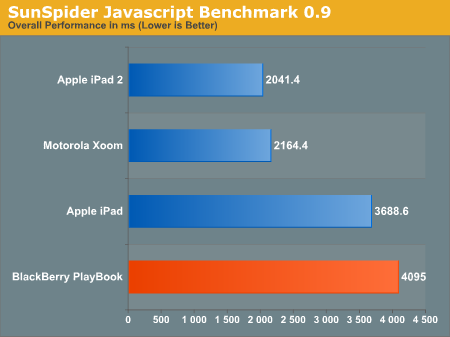
Here's something interesting. The PlayBook actually does a lot worse running SunSpider 0.9 (something we keep around so you can compare our numbers to our older smartphone results) than running version 0.9.1. I'm not sure what's the root cause but here's a look at the iPad 2 vs. PlayBook under SunSpider 0.9.1:
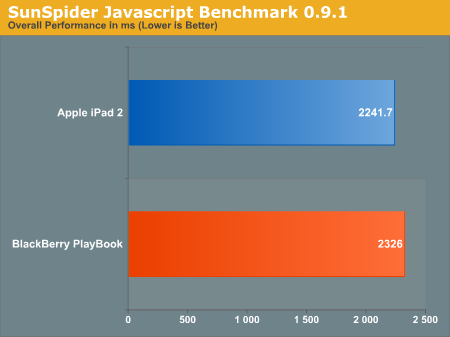
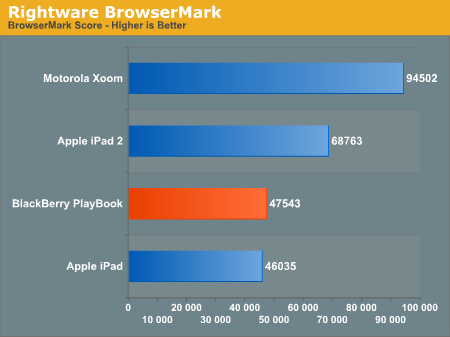
In BrowserMark the PlayBook is about the speed of the original iPad with a single Cortex A8. To me this sounds like there's just a lot of optimization work that has to be done on the browser's javascript engine, something both Apple and Google have worked on extensively over the past year.

Actual timed web page loads (without Flash) look a bit better for the PlayBook. On average the PlayBook managed to load our test pages (stored local on our network) faster than an original iPad but slower than the Xoom, and no where near as quickly as the iPad 2. If you look at the performance breakdown, the PlayBook handles some web pages nearly as well as the iPad 2 and others render slower than on the original iPad.
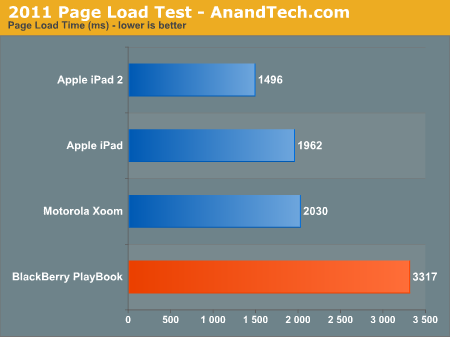

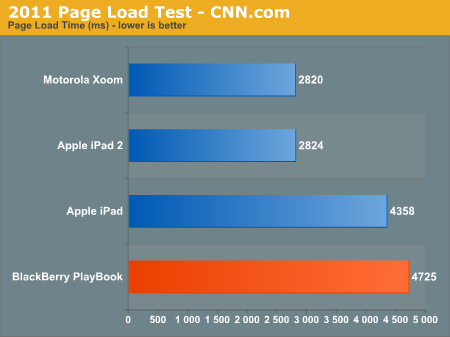
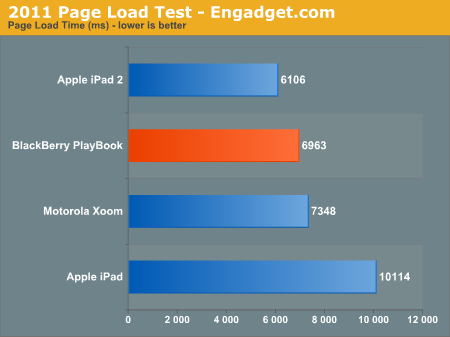

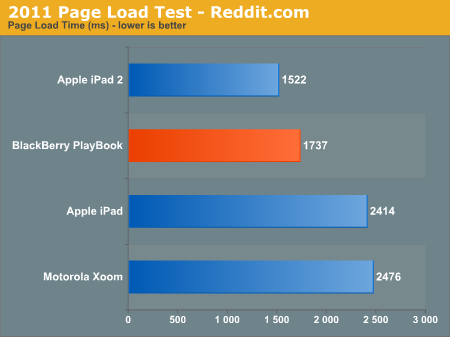
Our tests really stress the hardware/software since the pages are delivered as quickly as possible without any network delays. Outside of our test environment I'd say the PlayBook experience does mirror the performance tests. Browsing isn't slow by any means, but it's not exactly iPad 2 quick.
RIM tells me that its intentions are to have industry leading browser performance and that there's a lot of room for optimization left on the PlayBook. I believe that there's a lot more that can be done here, the question is how quickly will RIM get around to doing it.










77 Comments
View All Comments
legoman666 - Wednesday, April 13, 2011 - link
No email client? Really? Is that a joke?Ethaniel - Wednesday, April 13, 2011 - link
For now it seems, but that's clearly a sample unit. All I keep reading is "needs tuning" and "needs optimization", ergo, it's not ready, and they're going to launch it anyway. Those updates will have to be lightning-fast. I don't want to pay 500 dollars to be a beta tester...SimKill - Wednesday, April 13, 2011 - link
I'm actually surprised. This is because my cousin in India said that his friend in Dubai already bought it and has it for quite some time. Do you think there might be a reason why they are purposely delaying the American release?melgross - Thursday, April 14, 2011 - link
Probably, someone is lying about it, or they've gotten some illegally obtainedRe
Reduction model much as what happened the Apple's iPhone 4.
It's first being released in N. america, according to RIM.
vol7ron - Friday, April 15, 2011 - link
Why does everyone want to price around Apple? The more I look at these devices, the more I'm likely to get the color-nook and put Droid on it. Surely the hardware would be lacking, but the functionality would still be ballpark.16GB for $500 is ridiculous. These base models need to be in the $250-300 range.
michael2k - Friday, April 15, 2011 - link
Um, the raw materials for the iPad is about $260, meaning you can't expect to buy a 16gb tablet from any manufacturer, especially one with less buying power than Apple, for much less than $400 or so.From the iPad 2:
Display is $127
Flash is about $66 for 32gb, $35 for 16gb
Case & Battery is about $60
Mobo+Camera is about $60
So for any 10" tablet the cost if they gave it away for free would be $282 or so. Your nook "cheaps out" by having a 7" screen, only 8gb storage, a slower CPU, no cameras, and a much smaller battery. It only gets 8 hours with wifi off, the iPad 2 gets 11 hours with wifi on!
In other words you're only paying $180 worth of HW in the Nook, while the iPad gets you two 1GHz cores vs a 800MHz core, 11h of battery vs less than 8 hours, 10" and 1024x768 vs 7"@1024x600, 16gb vs 8gb, and of course, no guarantee of OS updates. You're complaint is ridiculous, actually, since almost no other manufacturer has been able to beat Apple on price yet except the Acer Iconia.
quiksilvr - Friday, April 15, 2011 - link
As much as I despise Apple, I have to agree to an extent. Yes that price is quite hefty, but if Apple didn't have it's cult following, it would have easily been on sale for $399. But thanks to idiot consumers, they can bump it up a Benjamin.michael2k - Friday, April 15, 2011 - link
And no one else can order in vast enough quantities to hit the $399 price.mcnabney - Friday, April 15, 2011 - link
I am starting to doubt the iSupply numbers you quoted.They price the very nice 9.7" IPS screen that Apple uses at $129 while the clearly inferior non-IPS screen the XOOM uses at $140. Their memory prices are also highly suspect, clinging to $2/GB for what are still really small drives compared where higher performing SSDs already are. I would guess that NAND prices for tablets are under $1/GB wholesale and in quantity.
michael2k - Friday, April 15, 2011 - link
Apple orders literally 2m 9.7" IPS screens a month, probably 40m this year alone. That gives them bulk purchasing power no one else has except the manufacturer of said screens.Motorola has to pay market prices, while Apple can literally buy an entire factory's output. http://www.isuppli.com/Display-Materials-and-Syste...
It doesn't help that the Japanese earthquake halted LCD production at major plants, either!
As for SSD chips, Apple is paying a premium to get density. The low end iPad has only a single SSD 16GB chip. The mid range iPad has one or two, and the high end has two 32GB chips. As soon as prices are good or capacity is good, I'm sure Apple will use a single 32gb chip on the low end, two 32gb chips for the middle, and 2 64gb chips on the high end.